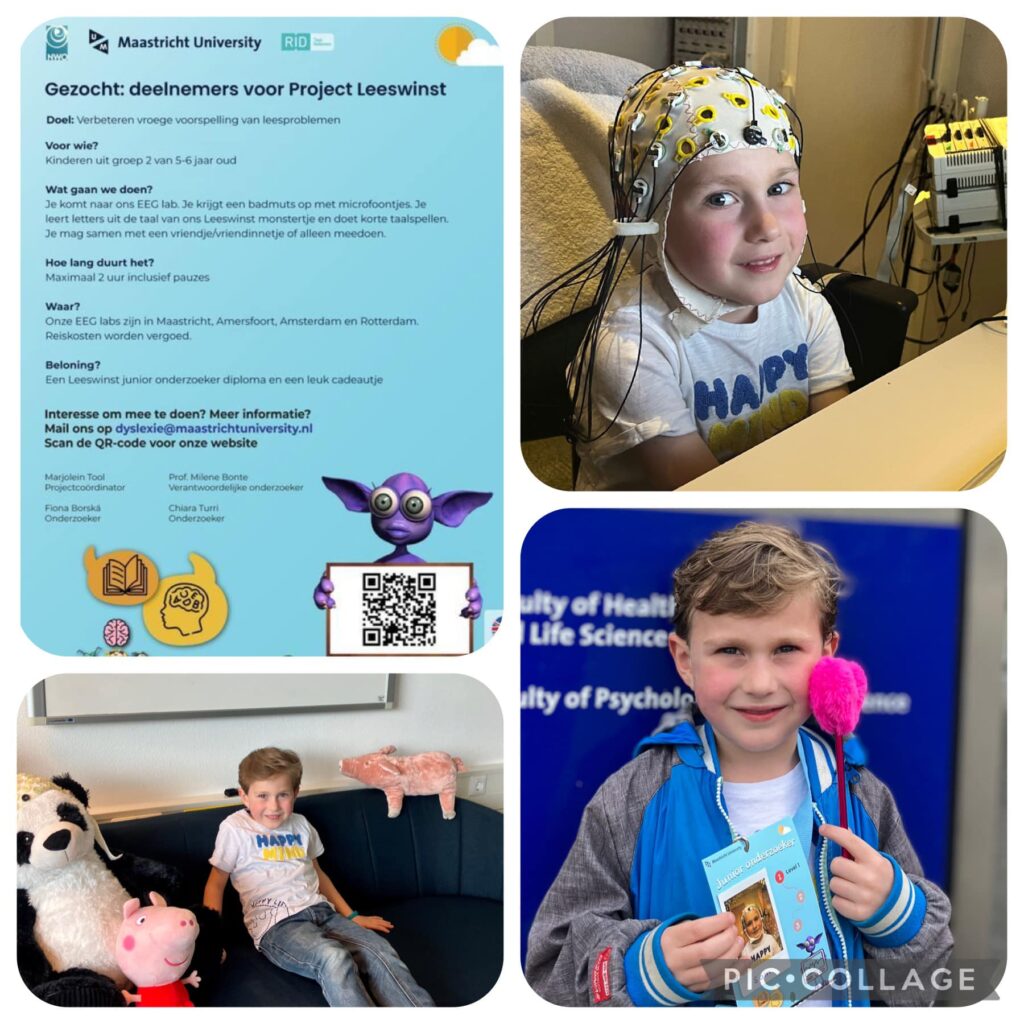First results Project Leeswinst
Comments Off on First results Project LeeswinstIn Project Leeswinst, we aim to improve early detection of reading problems by developing a learning task where children learn to pair new letter-like symbols to speech sounds. We investigate how children learn these new letters and how their brain activity changes during this learning. With this knowledge, we will develop a digital learning test that predicts who will learn to read fluently and who will need extra support to prevent reading problems.
We are very happy that 67 children already participated as junior researchers in our study and that other children will still join this summer. A sneak peek of our first results shows that children indeed show large differences in learning the new letters. Interestingly, children with and without a family member with dyslexia did not differ in letter learning. We do see that children with a family member with dyslexia tend to score slightly lower when asked to recognize which words start or end with the same sound (for example: boom | doos – raam – tak – wieg).
How did children’s brain activity change while they were learning the new letters? Faster learners show greater activity changes in brain regions that are important for reading development. For example, in audiovisual areas and in the frontal cortex, which is involved in attention skills.
The first children have now come back to visit our labs in Maastricht, Amsterdam and Amersfoort for the follow-up (level 2). We are excited to discover what the children have learned this year and whether our letter learning task is indeed a good predictor of reading problems. This summer, we will also start an fMRI study in Maastricht to better understand how the brain of 8–12-year-old children with/without dyslexia changes during letter learning.
We thank all participating families and schools for their support and look forward to sharing more results as the project continues!
Interested in participating? Go to our get involved page!
We are looking for children in groep 3 for ‘Project Leeswinst’!
Comments Off on We are looking for children in groep 3 for ‘Project Leeswinst’!The new school year has begun! Until now, a lot of children from eind groep 2 have participated in our study. This school year we are looking for children in groep 3 (5-7 year old children). Do you want to contribute to the early prediction of reading problems? Please participate in our research project!
What are we going to do?
- You visit our EEG lab. Your child will wear a swimming cap with microphones.
- Your child will learn letters from our Leeswinst monster’ language and play short language games.
- Your child can participate together with a friend or alone.
- It will take about 2 hours including breaks.
- We will make it a fun trip! See our Facebook and Instagram pages for an impression.
What is the reward?
- Leeswinst junior researcher diploma
- A nice gift
- Travel expenses wil be reimbursed
- In 2025-2026, we will organise a child symposium in which we share the results of our study with parents and children.
Where are our EEG labs?
In Maastricht, Amersfoort en Amsterdam
How can I participate?
Send an e-mail to dyslexie@maastrichtuniversity.nl of fill in the form on https://mbic-languagelab.nl/onderzoek/
NRO grant for Project “LeesKans”
Comments Off on NRO grant for Project “LeesKans”Thrilled to receive funding for our NRO project LeesKans: towards optimal interactive development of
early literacy and motivation! 📚
We will be developing and implementing a new ‘dynamic assessment’ tool to differentiate early reading
problems in a new way; based on learning potential rather than snapshots of already available knowledge. This will lead to fairer (reading) opportunities!
Project LeesKans is a collaborative project with consortium partners at UM (Milene Bonte), VU Amsterdam (Nienke van Atteveldt), RID dyslexie (Jurgen Tijms), UvA (Eddie Brummelman), IPABO (Inouk Boerma), Erasmus MC (Hanneke Scholten) en game design studio Game Tailors.
Start Project Leeswinst
Comments Off on Start Project LeeswinstIn April, we started the first measurements in Amersfoort and Maastricht. We are super happy with our first ‘junior researchers’! One of the participating parents shared a great impression on LinkedIn and Facebook.
Do you have a child in groep 2? Then sign up for Project Leeswinst via dyslexie@maastrichtuniversity.nl or via the ‘Get Involved’ button on the website!
